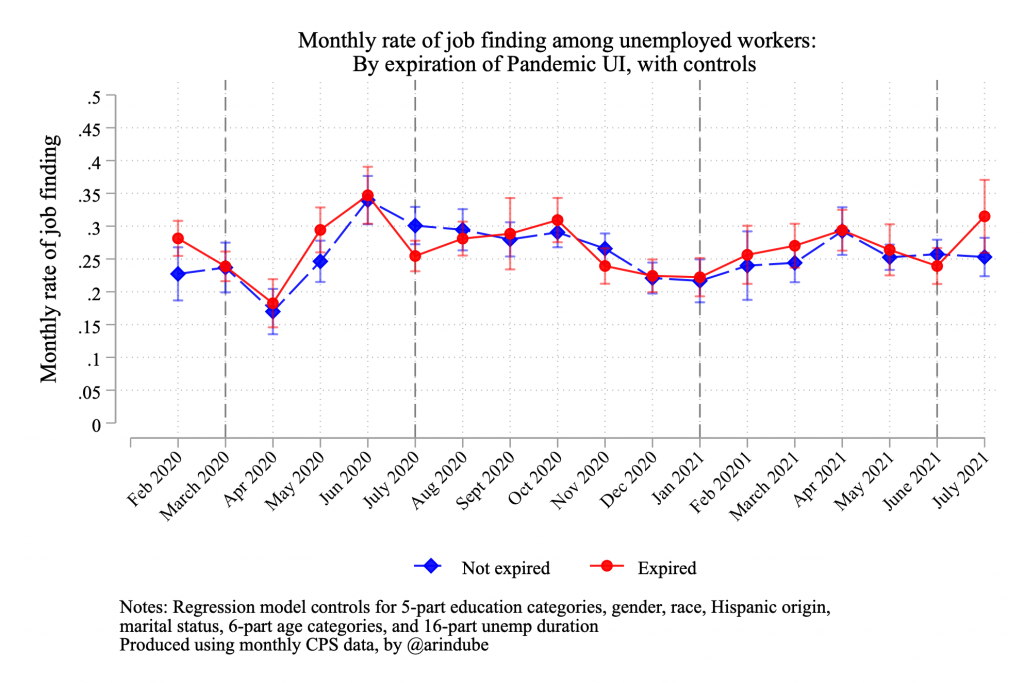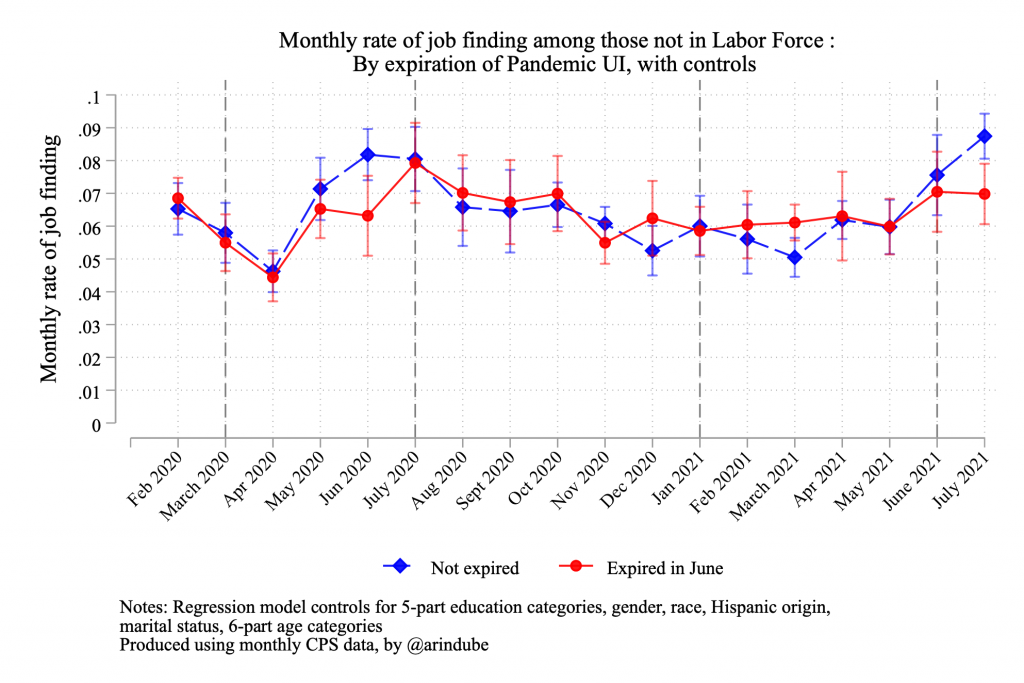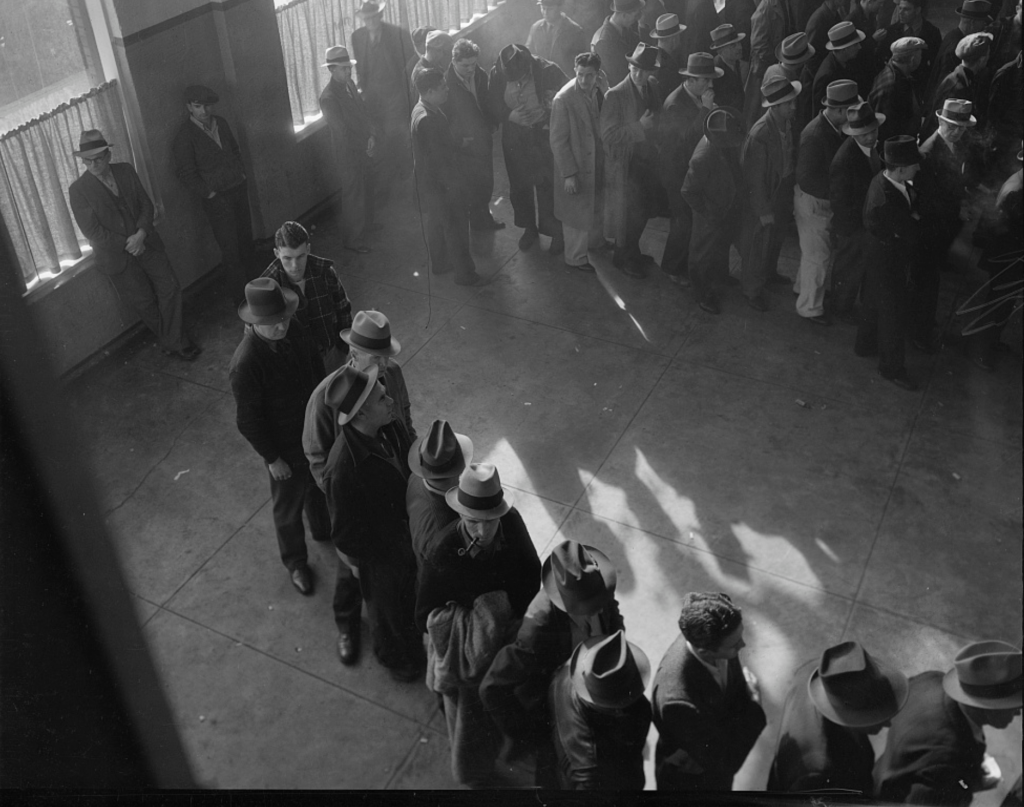Over at Slow Boring, Matt Yglesias has a piece that reads as a low-key defense of the decision to massively cut unemployment benefits on September 6. I’ve spent a few months covering this topic (most succinct summary here) and so I feel compelled to set the record straight on this policy change.
The Theoretical Case for Cuts
Yglesias dedicates much of his piece to the theoretical case for cuts. It is fairly straightforward and not inherently objectionable as a piece of theory.
It goes like this: the economy is currently overwhelmed by consumer demand while being undersupplied with labor. Cutting unemployment benefits reduces consumer demand by making unemployed people sharply reduce their spending and increases labor utilization by making unemployed people accept jobs. The result of this will be a cooling-off of inflationary pressures and, more concretely, increased employment and output.
The Theory Was Proven Wrong
This theory was tested during the summer when 26 states cut their unemployment benefit programs. Every public data source — the Current Population Survey, the Household Pulse Survey, and the BLS Establishment Survey — reported that employment did not increase in the cutting states relative to the non-cutting states. So if the goal is to contain inflation and plug up shortages by moving people off the unemployment rolls and onto the payrolls, cutting unemployment benefits has not helped us achieve that goal.
Cutting unemployment benefits does reduce income and spending and so, from a pure demand-throttling austerity perspective, that could help reduce shortages and inflation. But the amount of spending we are talking about is a drop in the bucket macroeconomically speaking: $145 per week per unemployed person, which is $1.3 billion per week for all 9.3 million people subject to the September 6 cuts.
If you were really aiming to control inflation by reducing transfer incomes, cutting the entire incomes of unemployed people is a pretty brutal way to go about it. Much better would be to just trim back all transfer payments — SS, SSI, UI, CTC, EITC, SNAP, etc. — by a small percentage.
The 2020 and Summer 2021 Research Shows the Same Thing
To reach the opposite conclusion on this, Yglesias compares two studies on the effect of UI, one that researched the effect of UI increases in 2020 and another that researched the effect of UI cuts in the summer of 2021. He seems to think that they reach different conclusions, but they don’t.
Here’s Yglesias:
During 2020, when there were so few job openings, it made especially good sense to focus on stabilizing demand with generous UI. Research done during 2020 showed that bonus UI did reduce job search intensity among those who got it — it just didn’t raise overall unemployment because there were so many people on furlough that it was easy to fill the scarce vacancies.
Flash forward to the summer of 2021, and there are tons of job vacancies, so Republican governors start canceling bonus UI early. Academic research shows that these cancellations had a modest positive impact on speeding job matching. Except the actual headline of the piece I just linked to was “Cutoff of Jobless Benefits Is Found to Get Few Back to Work,” a more negative framing of the exact same finding.
Both studies found that the presence of UI slightly reduced jobseeking and jobfinding among those receiving UI. The first study explicitly found that this did not have any aggregate impact on employment. The second study did not determine what impact the increased jobfinding had on aggregate employment.
Second, our job finding estimates miss some of the “congestion” effect created by increased job search. This arises from the fact that people who lost their UI benefits are applying to the same job postings as others in the labor market, and some of those other people (e.g. teenagers) are now passed over for jobs they would have taken.
What this study did was peak into the bank accounts of around 18,000 “low-income and credit-constrained workers” who were receiving UI at the end of April, some in states that cut UI and some in states that did not cut UI. By following their bank accounts over time, the researchers were able to determine that 21.5 percent of the people in the non-cutting states found employment by August while 25.9 percent of the people in the cutting states found employment by August.
Put differently, the researchers found that eliminating the unemployment benefits of 100 people caused 5.6 of them to find a job. But they do not answer the question of whether those 5.6 people filled jobs that would have otherwise gone unfilled (increase in aggregate employment) or instead filled jobs that someone else would have filled anyways (no increase in aggregate employment).
To answer this question, one of the study authors, Arin Dube, posted an analysis of the Current Population Survey to his website on the same day that the study released. Unlike the bank-transaction data, which only looked at people receiving UI, the CPS data looks at everyone. So you can actually see whether the small increase in jobfinding among those receiving UI resulted in extra employment or just elbowed out other people who would have filled the job in the counterfactual scenario.
The CPS makes this analysis pretty easy because CPS survey respondents are interviewed for 4 straight months. So you can match respondents across two months and count up how many reported as “unemployed” in month one and then as “employed” in month two. Divide the respondents into cutting and non-cutting states and control for demographics and you get your expected results: the percentage of people who went from “unemployed” to “employed” ticked up in the cutting states relative to the non-cutting states, just like the bank-transaction study shows (see the red line ticks up while the blue line stays flat).

But, unlike the bank-transaction data, the CPS data also allows us to see what happened to other jobseekers who were not on unemployment benefits. To determine this, you do the same thing as above, except this time by tracking how many people reported as “not in labor force” in month one and then “employed” in month two. When you do this, you see it clear as day: the percentage of people who went from “not in labor force” to “employed” went down in cutting states relative to non-cutting states (see the blue line ticks up while the red line stays flat).

As Dube notes:
The take-away is that the modest increases in employment suggested by job finding among those who were unemployed is unlikely to show up as aggregate job numbers due to substantial reduction in flows into employment from those who were initially not in the labor force.
All of this is to say that Yglesias is wrong to conclude that, unlike Marinescu et al. (2020), Coombs et al. (2021) found that the summer cuts increased aggregate jobfinding. It explicitly does not find that as the data source it is working with does not shed any light on the question, and then one of the authors of the paper posted an analysis of a data source that does shed light on the question that specifically shows the cuts did not increase aggregate jobfinding. The BLS Establishment Survey also showed this. So the 2020 and summer 2021 research is actually reaching the exact same conclusion.
When to Cut
At the end of his piece, Yglesias says that the pandemic UI benefits have “outlived their time.” But there is, as of yet, zero indication that this is true. We ran a nearly perfect experiment on this question in the summer when we eliminated the pandemic UI benefits for half the states while retaining them for the other half and the result of the experiment was that the cuts had no impact on aggregate employment.
A wise planner would have simply waited until there was evidence of aggregate employment boosts in the states that cut benefits until following suit in the non-cutting states. The relevant data comes out every month. Instead, we looked at the results of the experiment, saw that cutting states had fared no better than non-cutting states, and then cut the benefits across the entire country with absolutely no reason to believe it would do anything other than increase misery among the unemployed population.
As a final note here, it is also worth reflecting on the question of how much employment gain would be necessary to justify UI cuts as harsh as those delivered on September 6. Thankfully we have not yet had to have this discussion because the employment gain has been zero and no unemployment cuts are worth zero employment gain. But you could imagine a scenario where there was an actual tradeoff between maintaining pandemic UI and increasing employment growth, and so that hypothetical is worth indulging as well.
In analyzing this question, you should start by sorting the unemployed into three buckets: (1) those that will find a job with or without the cuts, (2) those that will remain unemployed with or without the cuts, and (3) those that will remain unemployed without the cuts but will find a job with the cuts.
In the Coombs et al. (2021) study, the numbers were: (1) 21.5 percent would find a job either way, (2) 74.1 percent would remain unemployed either way, and (3) 4.4 percent would have been unemployed without cuts but find a job with cuts.
As discussed already, the 4.4 percent in the Coombs study did not reflect aggregate job gains, but for our hypothetical, let’s imagine that they purely went to aggregate job gains and that none of the jobs they found came at the expense of other jobseekers. Would these cuts be justified in that case? To me, the answer is obviously no. Eliminating the incomes of 16.8 people (74.1/4.4) in order to move 1 person from the UI rolls to payrolls is completely insane.

